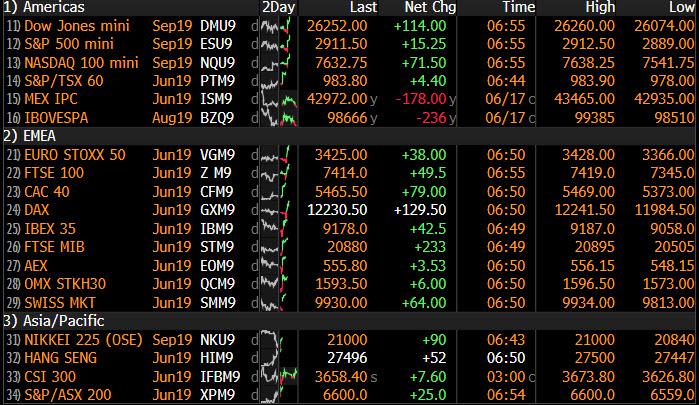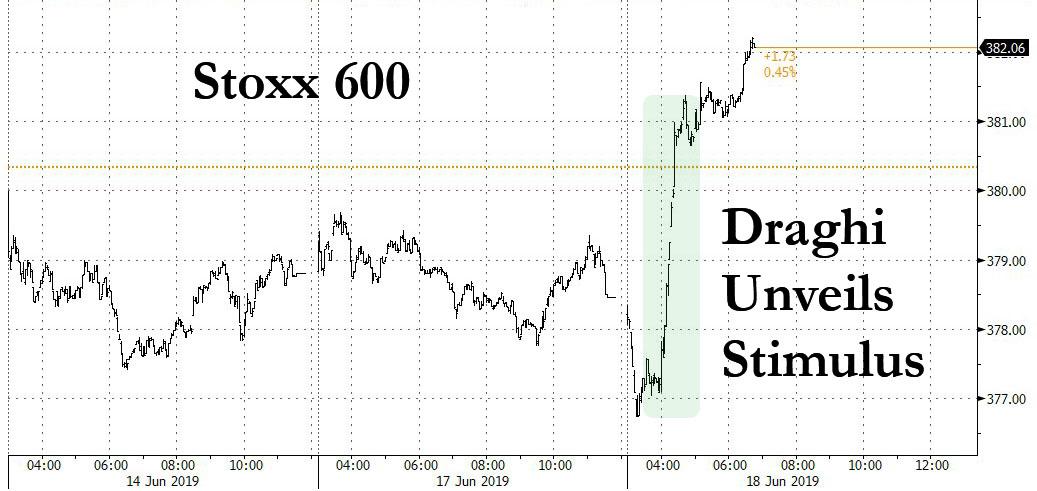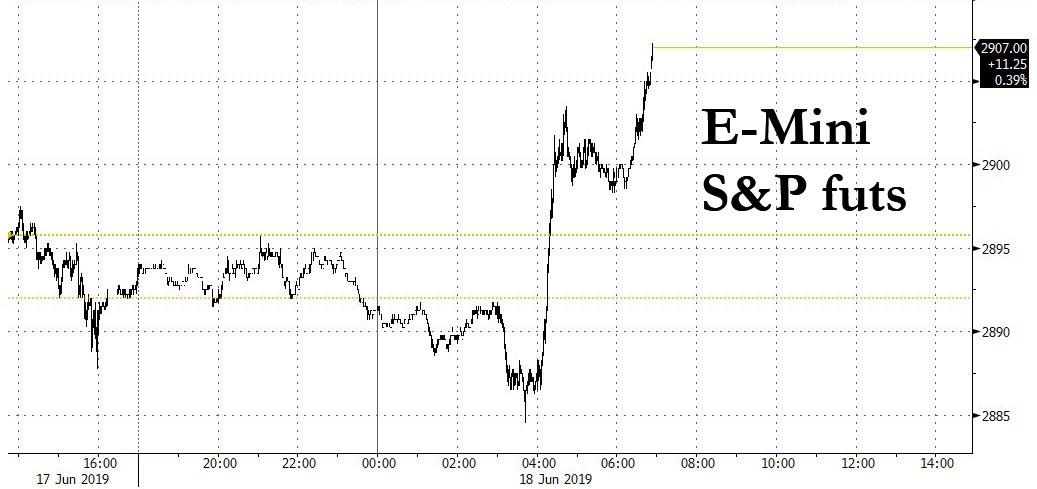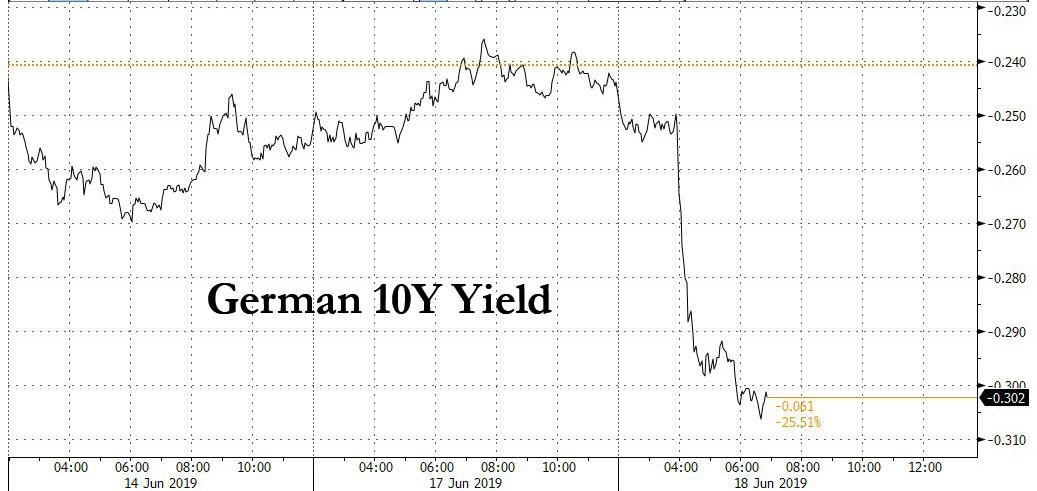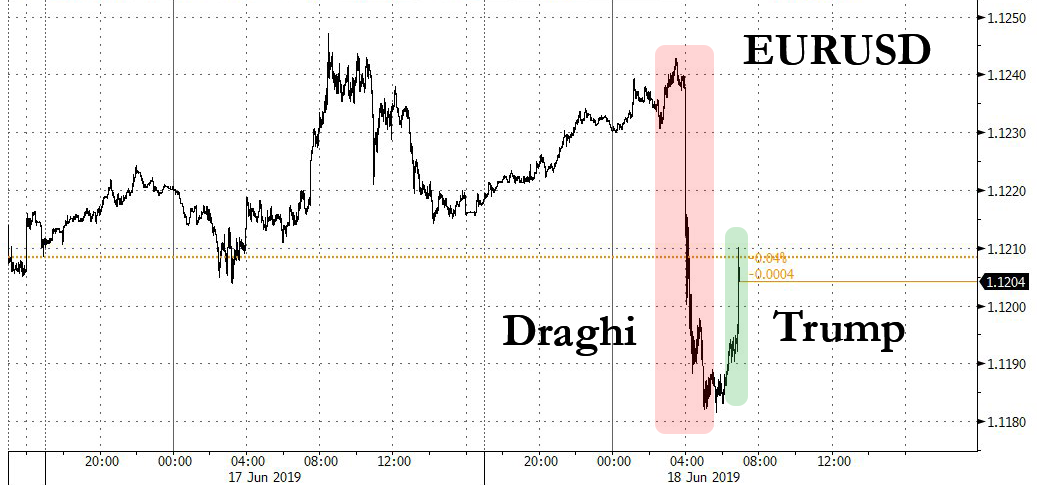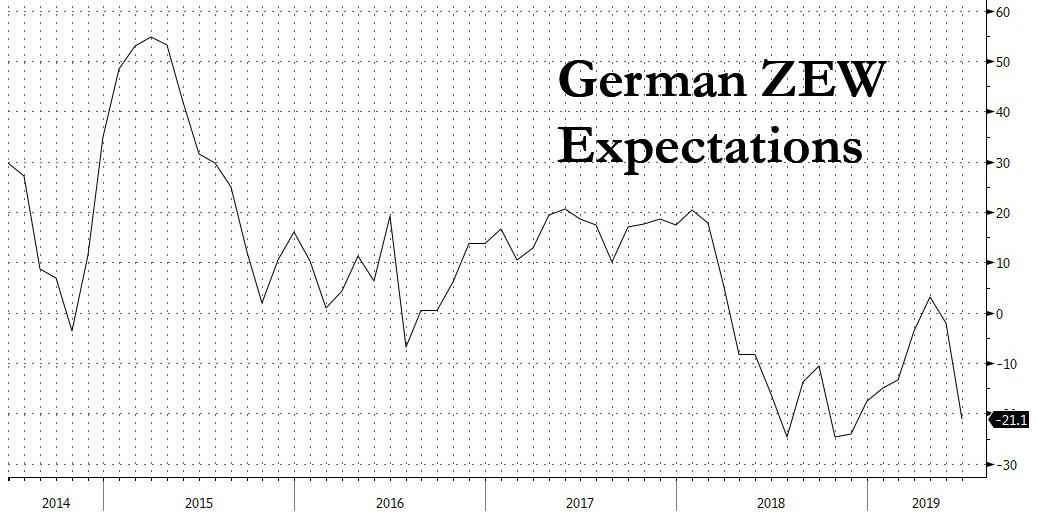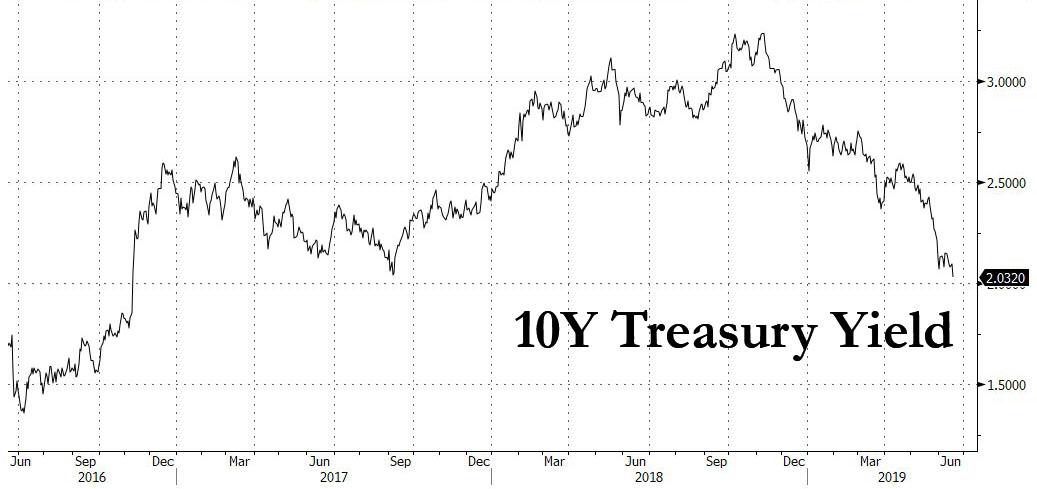It was shaping up as a slow, boring session with everyone waiting “patiently” for the Fed tomorrow, until right after the European open, when two years after Mario Draghi first laid out the blueprints for the ECB’s rate normalization with a speech about the Eurozone’s “strengthening and broadening recovery” at the ECB’s Sintra forum in 2017, the ECB president finally threw in the towel and said that if the outlook doesn’t improve and inflation doesn’t strengthen, “additional stimulus will be required” adding that the ECB can amend its forward guidance, that rate cuts remain “part of our tools” and asset purchases are also an option. In short, full dovish capitulation by the ECB chief, which in a market addicted to monetary stimulus, was just what the bulls needed to hear.
The news sent global stocks surging…
… the Stoxx 600 rebounding from a loss to a gain of over 1%…
… S&P futures up 14 points, and back over 2,900…
… the German 10Y Bund yield tumbling to an all time record low below -0.30%…
Amusingly, Draghi’s somewhat striking admission of defeat, prompted an immediate response from none other than the US president, who tweeted “Mario Draghi just announced more stimulus could come, which immediately dropped the Euro against the Dollar, making it unfairly easier for them to compete against the USA. They have been getting away with this for years, along with China and others”…
Mario Draghi just announced more stimulus could come, which immediately dropped the Euro against the Dollar, making it unfairly easier for them to compete against the USA. They have been getting away with this for years, along with China and others.
— Donald J. Trump (@realDonaldTrump) June 18, 2019
… then immediately followed by “European Markets rose on comments (unfair to U.S.) made today by Mario D!”
European Markets rose on comments (unfair to U.S.) made today by Mario D!
— Donald J. Trump (@realDonaldTrump) June 18, 2019
This in turn served to push the Euro slightly higher, recovering some of its losses, as Trump’s warning was interpreted as a threat of more Eurozone tariffs, or alternatively, more pressure on the Fed to cut rates…
… as the final race to the bottom emerges, and looks as follows:
- ECB unveils more easing
- Trump threatens ECB, responds with Eurozone tariffs
- ECB unveils even more easing
So with all these fireworks taking place in just a few short hours, what else happened?
Well, earlier, Japan’s Topix slipped, even as most Asian gauges rose. With European sovereign bonds soaring, led by Italy and Greece, while the Swedish and Austrian 10Y yield dropped below 0% for the first time, as fuel was added to the fire by a report that investor confidence in Germany’s economic outlook worsened dramatically in June…
… US 10Y Yields plunged to new lows, and just 3.2bps away from a 1-handle!
Of course, Draghi isn’t even the main event. Traders were far more focused on what the Federal Reserve announces on Wednesday to see whether Chairman Jerome Powell and his colleagues will validate widespread expectations for interest-rate cuts. The ECB’s announcement may just have changed the calculus.
In currencies, the Bloomberg Dollar Spot Index erased declines as the euro first fell below $1.12, then rebounded above it. Money markets are pricing in a 10bps cut by December from the European Central Bank after President Mario Draghi emphasized the need for stimulus. The kiwi dollar led gains in the Group-of-10 currencies, while the yen was boosted from demand versus the Aussie after RBA’s latest minutes showed more easing is likely
In commodities, oil dropped, with OPEC nations still unable to agree on a date for their next meeting, adding to uncertainty over whether production cuts would be extended.
Expected data include housing starts and building permits. Adobe is among companies reporting earnings
Market Snapshot
- S&P 500 futures up 0.5% to 2,911.00
- STOXX Europe 600 up 0.6% to 380.85
- MXAP up 0.3% to 154.95
- MXAPJ up 0.6% to 507.49
- Nikkei down 0.7% to 20,972.71
- Topix down 0.7% to 1,528.67
- Hang Seng Index up 1% to 27,498.77
- Shanghai Composite up 0.09% to 2,890.16
- Sensex up 0.4% to 39,102.96
- Australia S&P/ASX 200 up 0.6% to 6,570.00
- Kospi up 0.4% to 2,098.71
- German 10Y yield fell 5.0 bps to -0.294%
- Euro down 0.2% to $1.1191
- Italian 10Y yield fell 4.8 bps to 1.933%
- Spanish 10Y yield fell 6.8 bps to 0.458%
- Brent futures down 0.7% to $60.54/bbl
- Gold spot up 0.4% to $1,345.06
- U.S. Dollar Index up 0.1% to 97.68
Top Headline News from Bloomberg
- ECB’s Draghi said if the outlook doesn’t improve, and inflation doesn’t strengthen, “additional stimulus will be required.” He noted that the ECB can amend its forward guidance, that rate cuts remain “part of our tools” and asset purchases are also an option. He was speaking at the ECB’s annual forum in Sintra, Portugal
- Bond investors are preparing for another wave of QE from the ECB by returning to some of their favorite post-crisis trades. First up: buy the debt of nations such as France that have greater scope for purchases by the ECB. Next, bet on a drop in longer-maturity yields relative to near-term rates. Then go for higher-returning bonds, like Spain and Italy
- Investor confidence in Germany’s economic outlook worsened dramatically in June after the Bundesbank predicted the economy will shrink this quarter. An index measuring prospects for the next six months fell to -21.1 in June, a far worse reading than the -5.6 economists expected
- President Donald Trump’s top trade envoy Robert Lighthizer will be in the congressional hot seat for two days this week, giving lawmakers the chance to grill him about the prospects for a deal with China, as well as various punitive measures threatened by his boss
- Hong Kong leader Carrie Lam personally apologized for backing a bill that would allow extraditions to China for the first time, her latest move to try and defuse protests that have rocked the city
- Australia’s central bank is likely to lower interest rates again to drive increased hiring and boost households’ confidence that inflation will return to target. RBA says further rate cut ‘more likely than not’ in period ahead
- China cut its U.S. Treasury holdings to the lowest in almost two years as the months-long trade conflict dragged on between the world’s two largest economies. The nation’s holdings of notes, bills and bonds declined by $7.5 billion in April to $1.11 trillion, according to Treasury Department data released on Monday
- Rory Stewart, the rank outsider in the contest to become Britain’s next leader, is suddenly winning support and giving his bigger-name rivals a reason to worry. Officials working for three better-known contenders privately said they believed Stewart could deliver a major upset in the Conservative Party leadership votes this week
- The U.K. economy will probably flatline in the second quarter and the Bank of England won’t raise interest rates until well into next year, according to a Bloomberg survey
Asian equity markets mostly saw cautious gains ahead of this week’s key risk events and following the marginal gains in the US where trade was otherwise uneventful aside from the strength in tech and telecoms. ASX 200 (+0.6%) and Nikkei 225 (-0.7%) were mixed with Australia led higher by tech and commodity related sectors, in which government plans to introduce a AUD 158bln income tax cut package, as well as anticipation for further RBA policy easing, added to the optimism. Tokyo sentiment was hampered by a firmer currency. Hang Seng (+1.0%) outperformed as business returned to normal following the recent protests and the Shanghai Comp. (+0.1%) was indecisive despite continued PBoC liquidity efforts, as trade uncertainty lingered after economic regulators refused to rule out using rare earths in the trade dispute and the Global Times Editor suggested the potential for a protracted trade war. Finally, 10yr JGBs initially traded steady amid the indecisiveness in the region but were later supported as sentiment in Japan further deteriorated and after the 5yr auction results showed a decline in yields and higher accepted prices from the prior month.
Top Asian News
- China Cuts Treasury Holdings to Two-Year Low Amid Trade War
- China’s Trade War Has Investors Flocking to Consumer Stocks
- Metro Pacific Said Preparing to Start $2 Billion Hospital Sale
European equities are higher across the board [Eurostoxx 50 +1.2%] as the region was bolstered by a dovish Draghi. The DAX (+1.2%) is now back above the 12k level after having visited a pre-Draghi low of 11,986, albeit gains are somewhat limited by a subdued IT sector, meanwhile, the FTSE 100 lags as the index fails to benefit from Draghi’s speech. In terms of sectors, financial names underperform amid the prolongation of negative rates. Defensive sectors are outperforming with healthcare and utilities the standout outperformers. Movers to the downside today include chipmakers following a profit warning from Siltronic (-13.0%) , citing US-China trade issues. The downbeat market outlook spilled onto STMicroelectronics (-2.0%), ASML (-1.2%) and Infineon (-5.7%), albeit the latter is more influenced by the launch of a capital increase to fund the Cypress Semiconductor acquisition. Finally, Lufthansa shares rest near the foot of the Stoxx 600 following three separate broker downgrades.
Top European News
- Canary Wharf Group Is Said in Talks to Buy CapCo’s Earls Court
- Tieto to Buy Evry for $1.5 Billion in Nordic Software Tie- Up
- German Highway Toll Ruled Illegal and Discriminatory by EU Court
- Weidmann Waits as Merkel’s Candidate for Juncker Job Falters
In currencies, The EUR currency has slumped to the bottom of the G10 pile and even below the Aussie that was hit overnight by RBA minutes flagging further easing on the basis that benign inflation and wage trends are likely to persist for even longer. In similar vein, ECB President Draghi used the stage at Sintra to deliver a much more dovish/downbeat assessment of price developments and all but signalled another tweak to official guidance at the next policy meeting, if not further stimulus. In short, he acknowledged the recent pronounced drop in inflation expectations and said the GC will look at measures to counter the severity of risks to price severity in coming weeks, and if the situation fails to improve more stimulus will be needed. Eur/Usd has reversed from circa 1.1240 to just over 1.1180 and through 2.1 bn option expiries between 1.1195-1.1205 that may yet influence direction into the NY cut, while Eur/Gbp has pulled back sharply from around 0.8975 to 0.8925. Back down under, Aud/Usd is hovering off 0.6832 lows and Aud/Nzd has reversed towards 1.0500 as the Kiwi keeps tabs on the 0.6500 handle vs its US counterpart ahead of the latest GDT auction and NZ Q1 current account data.
- CAD/CHF/GBP – All weaker vs the Greenback and partly in sympathy with the Euro and Aussie, but the Loonie also had more negative Chinese-Canadian headlines to digest as Beijing suspended pork imports pending closer inspection of the product. Meanwhile, the Franc slipped through parity, but strengthened in Eur/Chf cross terms to 1.1175 at one stage and will do doubt arouse SNB attention given that the ECB seems to be on the brink of easing further (-10 bp now priced in for December). Elsewhere, Cable is now eyeing 1.2500 and very early January lows after breaching key support at 1.2560, with the next leg of the Tory leadership race looming before UK CPI, retail sales and the BoE unfolds tomorrow and Thursday.
- JPY/NOK/SEK – The major outperformers, as the Yen regains a safe-haven bid to retest support ahead of 108.00, while the Scandi Crowns benefit from single currency weakness and ECB-Norges Bank/Riksbank policy divergence given a widely expected hike from the former on Thursday. Moreover, the Sek derived some traction from a cautiously upbeat Riksbank business survey and significantly improved 2019 budget surplus forecasts from the SNDO. Eur/Nok around 9.7780 vs 9.8170 at one stage and Eur/Sek holding within a 10.6484-6147 range.
- EM – Although the Buck has rebounded firmly, if not quite uniformly as noted above (back over 97.500), the Lira has maintained recovery momentum with the aid of some rare constructive comments on the US-Turkey front and reports that talks about the S-400 deal will be held at NATO next week. Usd/Try trading near the base of a 5.8225-8777 band.
In commodities, WTI and Brent futures are lower on the day with the former just above the USD 51.50/bbl level whilst the latter hovers around the USD 60.50/bbl mark. News-flow for the complex was largely surrounding OPEC this morning, with WSJ noting that Saudi intends to push for tighter compliance to OPEC production curbs. Sources also stated that the renewed pact would see the under-complying countries reducing crude supply by 300-400k BPD. In terms of a date, IFX reported that Moscow has reportedly agreed to consider an OPEC+ meeting on July 12th, postponed from the scheduled June 25/26. Looking ahead, traders will be keeping an eye on tonight API inventory release with the street looking for a draw of around 1.75mln barrels. Elsewhere, gold is hovering near intraday highs amid a bout of demand for the safe haven asset. Meanwhile, copper prices are supported despite the underlying risk off tone in the market as Glencore has shut down its Mufulira copper smelter at its Mopani copper mine in Zambia whilst Chile’s Codelco said the Chuquicamata copper mine maintained output capacity at 50% due to the 4th full day of a union strike.
US Event Calendar
- 8:30am: Housing Starts, est. 1.24m, prior 1.24m; MoM, est. 0.4%, prior 5.7%
- 8:30am: Building Permits, est. 1.29m, prior 1.3m; MoM, est. 0.23%, prior 0.6%
DB’s Jim Reid concludes the overnight wrap
I’m still in NY and last night I FaceTimed home to find there had been a big furniture delivery. No, not for our new house, but for my daughter’s new dolls house. I bought what I thought was a very good value but nice one only to find that the real money has to be spent furnishing it. It comes completely undecorated and bare. I had a bit of a shock when I saw how much all the trappings to go inside cost. So yesterday a four poster bed, a dining table and various kitchen appliances arrived. Then we spent most of the rest of the conversation debating whether we should also buy dolls house wallpaper! There is part of me that wondered whether I imagined this conversation in some kind of surreal jet lag haze but alas it was only too real.
It was a bit of a sleepy first day of the new week for markets yesterday with fairly minimal news flow to trade off. The good news, however, is that we’ve got a full day of the ECB Forum in Sintra ahead of us and today’s agenda includes an introductory speech from Draghi this morning, comments from various ECB officials including Guindos, Praet, Lane and Coeure, and then a policy panel featuring Draghi, the BoE’s Carney and former Fed Vice Chair Fischer this afternoon. It remains to be seen what will come of the Forum; however, as we mentioned yesterday, we have seen markets move sharply in previous years following comments that emerged from Sintra and with there being plenty of chatter about potentially more stimulus coming from the ECB, it’s worth watching it closely. In his opening remarks last night, Draghi declined to discuss policy or the current outlook, instead keeping his comments focused on the conference and on introducing Olivier Blanchard, who used his keynote address to argue for greater use of fiscal policy in the next downturn; an unusual topic for a central banking conference!
Ahead of the conference yesterday, comments from the ECB’s Coeure attracted a bit of attention following an interview with the FT. Coeure highlighted the dilemma the ECB faces with market pricing, saying that the ECB should neither ignore it nor blindly follow it. Most notably, Coeure said the costs associated with easing policy should not deter the ECB from acting – while also going on to mention rate cuts and the impact of NIRP on banks. In addition to those potential tools, he cited QE and forward guidance as other options. Coeure acknowledged the existing limits on bond-buying, but emphasized that the limits were chosen by the ECB, not by the ECJ or some other outside force, thus hinting that they could be modified. In a similar vein to Blanchard last night, he hinted at the frustration at the lack of fiscal policy from those that could potentially do it. This lack of action might force the ECB to do more in the future, which in turn would magnify the potential lower for longer problem.
With the exception of BTPs – which rallied -4.8bps on minimal news – bond markets were slightly weaker yesterday with 10y Bunds up +1.2bps in yield to the lofty heights off -0.247%. Similarly, Treasuries were +1.4bps higher although they did see a slight rally on the back of a shockingly weak empire manufacturing reading – the biggest monthly decline ever in fact. We’ll have more on that below. That being said, equity markets didn’t appear too fussed with the NASDAQ leading the charge following a +0.62% bounce. FANGS led the way with the NYSE FANG index up +1.75%, though the Philly semiconductor index retreated -0.64%, as cyclical sectors more broadly underperformed. Banks retreated -1.00% and the DOW transports index fell -1.03%. Elsewhere, the S&P 500 (+0.09%) and the STOXX 600 (-0.09%) were both little changed. HY credit spreads were -2bps tighter in the US, while the dollar traded flat. EM currencies were flat as well, while EM equities fell -0.36%.
This morning in Asia markets have mostly followed the lead from Wall Street; however, the exception is the Nikkei, which is down -0.70% after BoJ Governor Kuroda said that the “risks to the global economy are tilted to the downside”. A reminder that the BoJ meeting is this Thursday. Elsewhere the Hang Seng (+0.73%), Kospi (+0.38%) and Shanghai Comp (+0.08%) are all up. In other news, Chinese holding of US Treasuries are continuing to decline with the US Treasury Department data released yesterday highlighting that China’s holdings of US notes, bills and bonds declined by $7.5bn in April to $1.1tn, the lowest since June 2017.
Staying with Asia, yesterday news also broke that President Xi will travel to North Korea on June 20-21, the first time a Chinese leader has made the trip in 14 years. It is possible that North Korea talks are another arena of the US-China confrontation, so developments there could reverberate back onto the tariff war. Separately, Chinese tech giant Huawei said that the new Western sanctions will cost them around $30bn this year and next, as they anticipate 40-60mn fewer smartphone sales this year. While many countries have not joined the US in sanctioning the company, the threat and uncertainty surrounding the firm is enough for many major wireless providers to opt not to carry Huawei’s newest phone model. This was the first time that the company quantified the impact of the US’s sanctions, and the new information was worse than expected.
Also on the trade front, it’s worth keeping an eye on any headlines that could potentially emerge from US Trade Representative Lighthizer’s testimony before Congress today. While the aim of the testimony is to campaign to get Congress to approve the US-Mexico-Canada trade agreement, there’s a reasonable chance that US-China trade issues also get brought up. So that should be worth a watch.
While we’re on politics, here in the UK we’ve also got the second Conservative Party leadership ballot. The cut-off for this round is 33 votes. Unsurprisingly, Johnson remains the front runner following the first round and since then we’ve seen him pick up further support, including that of Health Secretary Matt Hancock – a former contender. While we’re on UK politics, Bloomberg has reported overnight that the UK Chancellor Philip Hammond might leave the government over PM May’s plans to commit nearly £27bn in spending on education over the next three years as this will likely limit the ability of PM May’s successor. Sterling has faded slightly on the back of the story.
Back to the data yesterday and specifically that empire manufacturing print in the US where the -8.6 reading was not only well below consensus for +11.0 , but also marked a drop of -26.4pts from the May reading, which is the biggest ever monthly change based on data going back to 2001. The outright monthly reading is also the lowest since October 2016 and it’s worth noting that this is the first regional Fed survey that usually helps to inform the ISM. The details didn’t make for much better reading, with new orders also down sharply and into negative territory along with employment. So worth watching how other survey data plays out in light of this very soft reading, which will raise concerns about further deterioration in the ISM. Our US economists cited the deterioration in sentiment as a key factor when they downgraded their US growth forecast last week (link ), with the bulk of the -0.4pp revision to 2019 growth coming from reduced capex activity.
As for the other data, the US NAHB housing market index slid -2pts to 64, its first decline of the year. That’s still near its recent cyclical highs. Homebuilder stocks retreated -0.52%, though they actually remain within a percent of their highest levels in a year. In Europe, labour costs rose 2.4% yoy in the first quarter, a 0.1pp acceleration from last quarter. That provides some evidence of tightening labour markets feeding through to wages, albeit gradually.
Looking at the rest of the day ahead, this morning we get the April trade balance and the final May CPI revisions for the Euro Area, as well as the June ZEW survey in Germany, which is expected to deteriorate from the May levels. In the US, we’ve got May housing starts and building permits data. The big event today though is the aforementioned ECB forum in Sintra. Meanwhile, the second ballot in the UK Conservative Leadership Party contest will take place today, while US Trade Representative Lighthizer is due to testify in Congress.
via ZeroHedge News http://bit.ly/2N9AhHt Tyler Durden
